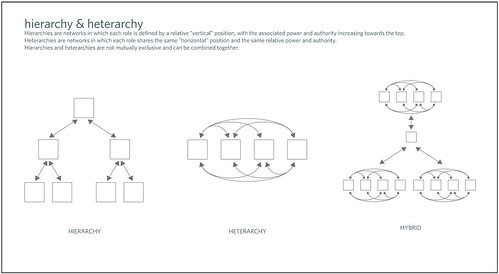In her talk at TEDxKoeln Adriana Lukas outlines the five laws of heterarchy - "Those might one day help write recipes for building a society of peer to peer interactions." P2P does rely more on heterarchical structures, but there are inherent hierarchies in most (if not all) systems.
The P2P Foundation Wiki offers this definition of heterarchy by Timothy Wilken:
"Heterarchy is a very different breed of organizational strategy than hierarchy. It is a horizontal system with only one level of organization. All are equal within the heterarchy. Individuals within the system see each other as being on the same level. “We are a team.” “Its like a family rather than a job.” “We all respect each other.”TEDxKoeln - Adriana Lukas: Balanced Asymmetry of Networks or How to Avoid Hierarchies
Heterarchy is ideal for communication and discussion, because it allows for the sharing of responsibility and authority within an informal environment. Task assignments following open discussions, produce more cooperative working relationships. In a setting where associates feel valued, openness and integrity emerge. Individuals often take much greater roles in the tasks of their departments. In this setting, there is less conflict, and this usually results in improvement in efficiency, productivity, and quality of work-life. Heterarchy creates a feeling of oneness — a feeling of community. Members of a heterarchy strongly identify with the whole system. Morale and espirit de corps are optimized. Because heterarchy is highly inclusive, all feel that they are a part of the system. This is in strong counter distinction to hierarchy's exclusiveness. Individuals within heterarchy tend to protect the system. Individuals within hierarchy often ignore the system, and sometimes even attack it. The wholistic focus of heterarchy is on the needs of the whole organization. This wholistic focus leads to collective decision making and collective responsibility.
Decision making in heterarchy is slower. It takes time to gain the consensus of all the individuals within the heterarchy. However, implementation is much more rapid because the attitudes of those responsible for implementation have been considered in the decision making process. This not only eliminates conflict, but also encourages all members to feel responsible for the successful implementation of the decision. Anyone who has ever built a house knows it is much less expensive to erase lines on a paper, than to demolish mortar, brick, and stone." (http://www.synearth.net/Restricted-Confidential/OT.pdf)
TEDxKoeln - "Stories of(f) Balance" brought together passionate listeners and speakers, well able to not only be multiplicators of ideas but also to act on them, in an exchange of moving stories and bold ideas and thus TEDxKoeln joins the global discourse of concerned citizens.I'm not sure why people are so phobic about hierarchies - some systems function better with hierarchies and some function better with heterarchies. I'm not convinced that heterarchies are better than compassionate hierarchies - as is true in many things, both are probably useful in certain situations, even within the same system.

No comments:
Post a Comment